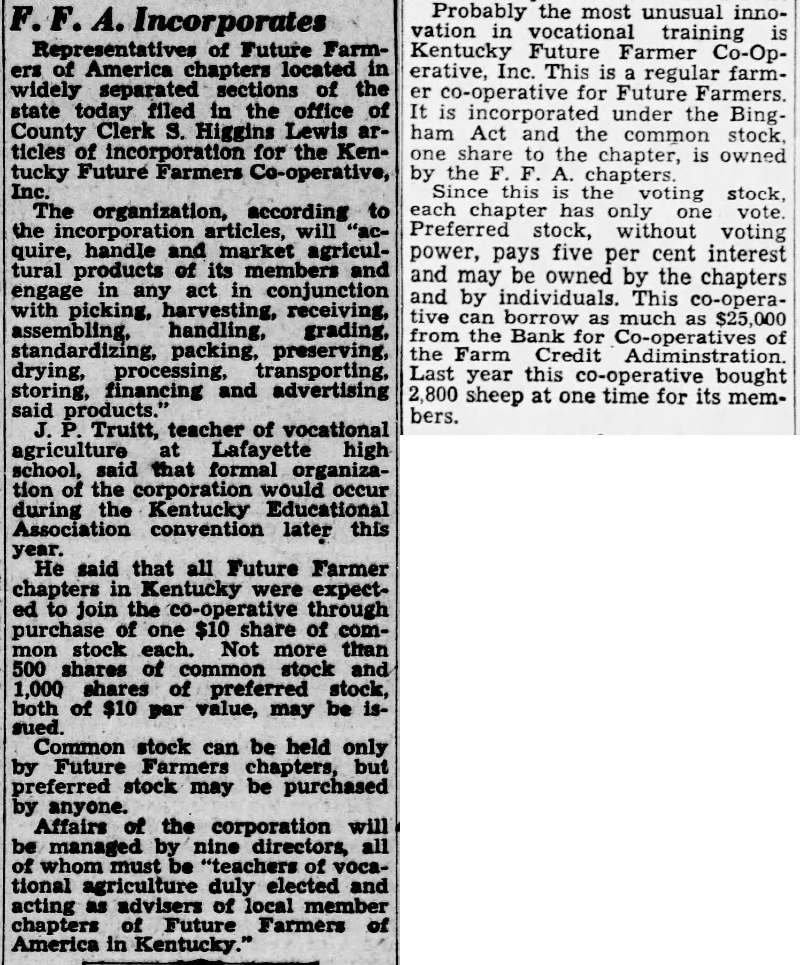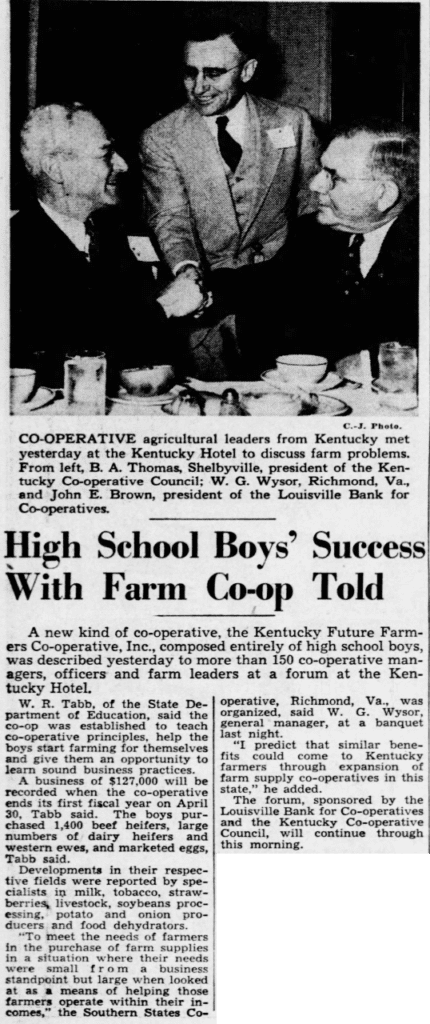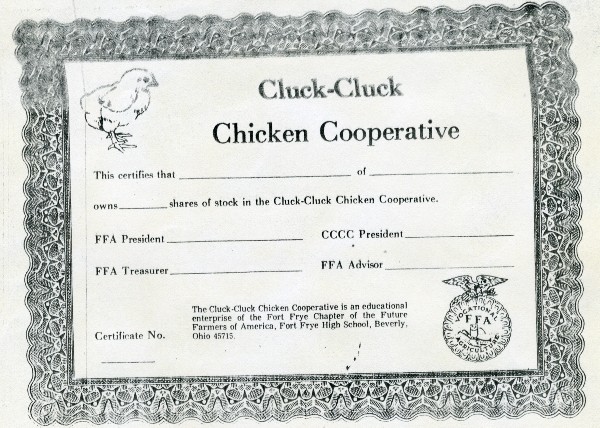As we continue our journey through the states via the Friday Footnote, we have arrived in Kentucky. In 1930 Kentucky received their national FFA charter, being the 39th state to do so. According to the latest FFA manual, Kentucky has 173 FFA chapters with 20,450 members. The Kentucky FFA application for a national charter is online.
Cooperation was the “In Word”
Cooperation as in “agricultural cooperatives” was a popular idea in the early days of the FFA. At the 1929 National FFA Convention the Program of Work committee recommended 16 objectives of which #12 was “Encourage each state to stage cooperative movements among its local chapters.” A handwritten note on the official minutes stated “(buy, sell or ship).” The same goal was found in the 1930 Program of Work and for a number of years thereafter.
At the 1929 FFA Convention, H. O. Sampson from New Jersey, spoke about “How to Succeed in Future Farmer Work.” He recommended (Minutes, 1929, p. 15) “Establish some local cooperative organization in each chapter” and he suggested members “Study all cooperatives in your neighborhood in an effort to learn their advantage.”
The 1931 FFA convention proceedings indicate the FFA chapters were starting to get the “cooperative” message. The proceedings (1931, p. 29) state “Twenty-nine States report chapters engaged in this type of activity. In certain instances it is confined to a very few chapters, while in other instances over half of the chapters in a State are participating in such an activity.” It was interesting to note that two of the four national public speaking contestants spoke about agricultural cooperatives at the 1931 convention.
The Agricultural Education Magazine started publication in 1929. The May 1929 issue theme was “Teaching Cooperation.” A variety of articles were published about cooperatives in this issue.
For the next decade, articles about FFA chapter cooperatives were published in The Agricultural Education Magazine. The national FFA convention proceedings had numerous mentions of cooperative activities of award winning chapters and students. An entire book could be written about student cooperatives in agricultural education during the first 50 years of the FFA.
The Kentucky Future Farmers Co-operative Inc.
While many FFA chapters across the country were engaged in a variety of cooperative ventures during the 1930s and 1940s, it appears the Kentucky FFA raised the cooperative bar. In 1943 the Kentucky FFA filed articles of incorporation with the secretary of state for the Kentucky Future Farmers Co-operative, Inc. According to the articles of incorporation the organization will (Lexington Herald-Leader, March 19, 1943, p. 2):
Acquire, handle and market agricultural products of its members and engage in any act in conjunction with picking, harvesting, receiving, assembling, handling, grading, standardizing, packing, preserving, drying, processing, transporting, storing, financing and advertising said product.
All FFA chapters in Kentucky were expected to join the co-operative by purchasing one $10 share of common stock. Not more than 500 shares of common stock and 1,000 shares of preferred stock were to be issued. FFA chapters were to hold the common stock, but preferred stock could be purchased by anyone.

Figure 1. A copy of a share of stock. Retrieved from the Kentucky FFA Association website.
The corporation was to have nine directors, all who must be teachers of vocational agriculture duly elected and acting as advisors of local FFA chapters. An article in the Lexington Herald (November 19, 1944) indicated this FFA cooperative was the only one of its kind in the United States; but that was not exactly true. The South Carolina Future Farmers’ Co-operative received their charter on December 11, 1943 (The State, Columbia, SC, May 2, 1944. It is interesting that the purpose of the SC cooperative is word for word the same as that found in the Kentucky document). Details about the Kentucky cooperative can be found in Figure 2.

Figure 2. The article on the left is from the Lexington Herald-Leader, March 19, 1943.
The article on the right is from the same newspaper, January 7, 1945.
Each FFA chapter with common stock had one vote in the annual meeting of the Co-Op which was held during the state FFA convention. Individuals and chapters who owned preferred stock had no vote but received five percent interest. If the Co-Op needed operating funds it could borrow up to $25,000 from the Bank for Co-operatives of the Farm Credit Association.
It did not take long for the word about the FFA cooperative to spread. At a meeting in Louisville in April of 1944 cooperative managers, officers and farm leaders learned about the Kentucky FFA cooperative. During its first year of operation the cooperative handled $127,000 in transactions. See Figure 3.

Figure 3. The Courier-Journal (Louisville), April 20, 1944.
Activities of the Kentucky Future Farmer Cooperative, Inc.
We learned from Figure 2 that 2,800 sheep were purchased through the cooperative in 1944. What else did the cooperative do?
The Kentucky FFA website states that “In 1943 alone, the cooperative helped members purchase 2732 breeding ewes, 23 carloads of beef heifer calves, 5 carloads of steer calves, and 4 truckloads of dairy calves and did over $125,000 in business.”
In 1946 FFA members in Kentucky, operating through the cooperative, bought 2,050 beef calves from the western states. They also purchased Guernsey and Holstein dairy cows from Wisconsin. See Figure 4.

Figure 4. The Courier-Journal (Louisville), December 19, 1946
It appears the Cooperative ceased to function around 1948. There are no mentions of the Kentucky Cooperative in Newspapers.com after the annual meeting in 1948.
Concluding Remarks
At one time cooperative activities involving FFA chapters and their members was an important activity as illustrated by the Kentucky FFA Cooperative. FFA cooperatives slowly diminished in popularity over time. However, they are still a good idea. Involving FFA members in cooperative activities might still be a good way to teach. I speak from personal experience.
While teaching high school agriculture at Fort Frye High School (Ohio) in the early 1970s I went home in a funk one Friday. The freshmen class was learning about poultry but were less than excited. The sophomore class was studying livestock nutrition and were not all that enthusiastic about Pearson’s Square. My junior class was studying livestock housing, and the seniors were learning about farm cooperatives. Boring to say the least.
Over the weekend I racked my brain trying to figure out how to make these topics more interesting and exciting. Then I had a Eureka revelation. Monday morning I assembled the FFA officers and shared my idea. They liked it and gave it the green light. At the next FFA meeting we voted to form a cooperative.
The idea was to organize the “Cluck-Cluck Chicken Cooperative.” We would raise chickens in a corner of the school shop. The senior class was given the responsibility for organizing the cooperative and getting it started. The junior class would have to design and build the housing for the chicks. The sophomore class would determine the ration for the chicks and the freshman class would have to identify the breed of chicken to raise and secure the baby chicks. I encouraged the students to interview their neighbors and learn everything they could about raising chickens.
We had the local printer print up share certificates. We then sold the shares for fifty cents. Every FFA member was expected to buy one share of stock and no one could buy more than 10 shares of stock. We even offered shares of stock to the teachers and other students in the school. See Figure 5.

Figure 5. The Cluck-Cluck Chicken Cooperative stock certificate.
Talk about excitement. I will spare all the details, but the Cluck-Cluck Chicken Cooperative was a rousing success and much learning occurred. Students were enthused. Teachers who had never been to the ag department visited to see the chicks. At the end of the school year we sold the chickens and returned 57 cents for each share of stock owned. I even saw stock certificates framed and hanging in living rooms.
Today we could organize livestock, garden, greenhouse, and a bunch of other cooperatives in our classes. It is something to think about.
